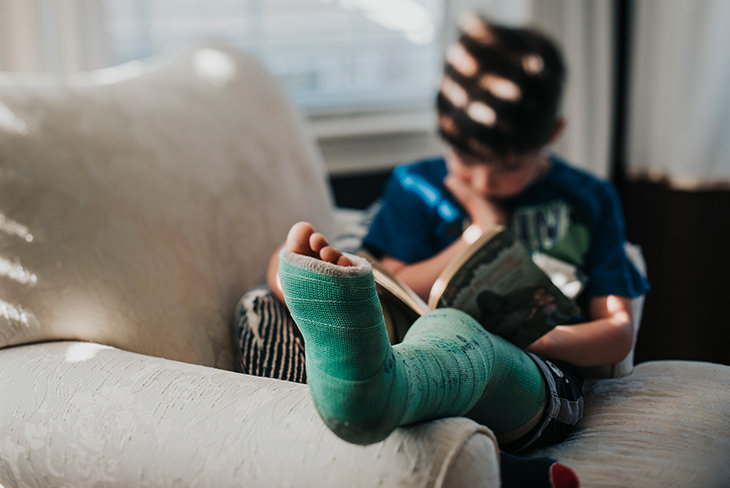Five common medical emergencies and what to look out for

While an estimated 60,000 South Africans are murdered or die in road accidents each year, at least 2.5 million cases of non-fatal injury receive medical care during the same period. This translates into about 66 trauma presentations per 1,000 people each year. Dr Charl van Loggerenberg, the General Manager of Emergency Medicine at Life Healthcare, talks through common situations that could require emergency medical care.
1. Broken-bone treatment
What is it?
‘Broken or dislocated bones from accidental trauma are usually not life-threatening, but may require emergency medical care,’ says Dr van Loggerenberg. A bone dislocation is when a bone slips or pops out of its joint, which can cause damage to nearby ligaments, nerves and blood vessels. A broken bone may not be obvious without an X-ray diagnosis, but the bone could present with a clean break or crack, or could be displaced bone that may or may not have broken the skin.
Signs and symptoms
- Pain during movement and inability to move the limb easily
- Numbness, tingling, swelling, skin discolouration or heavy bleeding at the injury site
- Bone protruding through the skin, if the bone has been displaced
Emergency treatment
In the emergency unit, medical staff will immobilise the injured part as best they can, and if there is an associated wound, apply compression to control bleeding. If a major joint or bone is involved, or there is a possible spinal injury, it’s best that a trained medical professional administers treatment.
2. General poisoning
What is it?
‘We see a variety of types of poisoning, including alcohol poisoning and ingestion of other toxic substances found in the typical household, which can lead to a total shutdown of normal bodily functions without treatment,’ he says.
Signs and symptoms – depend on the specific toxin
- Lack of coordination and unsteadiness
- Irritation in mouth, drooling, painful swallowing
- Vomiting, seizures, slow/irregular breathing
- Low body temperature and slow heartbeat
- Clammy and skin drained of colour
- Passing out/loss of consciousness
Emergency treatment
Treatment, according to Dr van Loggerenberg, is initially supportive and includes observation, perhaps rehydration via IV, medication if necessary and assessment of vital signs in the emergency unit. ‘Do not attempt to induce vomiting at home (some caustic substances can cause further harm) nor give anything (even water or milk) by mouth,’ he explains.
3. Gastroenteritis in children
What is gastroenteritis?
Gastroenteritis, also known simply as ‘gastro’, is a viral or bacterial infection of the bowel and may present with diarrhoea and sometimes vomiting and dehydration. It can be caused by many common viruses, for example rotavirus or adenovirus, or even bacteria from contaminated food or water. ‘Bacterial gastroenteritis in children tends to be more dangerous, as kids can dehydrate quickly,’ he says.
Gastroenteritis signs and symptoms
- Signs of dehydration (dry lips and fewer urine nappies)
- Watery stool, and possibly blood or mucus
- Stomach pain and vomiting
- Unusual sleepiness
Gastroenteritis treatment
In severe cases, hospitalisation may be required. Symptoms will be treated and possibly rehydration via IV administered as needed.
4. Burns
What is it?
Minor burns can be treated at home, but can cause infection and long-lasting skin damage if treated poorly. Burns can be from an open flame (cooking or heating sources), electricity or even chemicals and can cause various types of burns.
Burns signs and symptoms
- Appearance of blisters; red, mottled or weepy skin; or in the case of an extreme burn, dark or dry leathery skin
- Pain or swelling associated with tissue damage caused by burns
Burn treatment
Urgent medical attention is needed if the burn is large or very painful, or if any strategic area (like the hands or face or limb circumference) is involved. Remove jewellery and clothing around the burn area and flush with cool running water. Commercial burn gel dressings may also be used. Avoid ice or any ‘home remedy or ointment’, cautions Dr van Loggerenberg.
5. Asthma attack
What is asthma?
Asthma is a reversible inflammatory disease of the lungs, which causes breathing difficulties due to spasms in the tiny air passages, usually brought on by an environmental trigger, or an allergy or coincidental viral infection. A medical assessment is needed to classify the severity of the condition.
Asthma signs and symptoms
- Tightness or pressure in the chest
- Difficulty sleeping because of breathing problems
- Coughing, wheezing and shortness of breath
- Pale or blue face, lips or extremities
- Feelings of panic and anxiety and a sweaty face
Asthma treatment
‘People living with asthma should already have a plan of treatment developed with their doctor, using airway dilation medications (via an inhaler or pump) and special anti-inflammatories,’ explains Dr van Loggerenberg.
‘However, sometimes emergency care is needed with an asthma attack in progress, [as this condition] can be potentially life-threatening.’ If the shortness of breath is not immediately relieved using the patient’s own medication, always seek emergency care.
Life Healthcare’s emergency units are located at 41 Life Healthcare hospitals and offer emergency medical services 24 hours a day, seven days a week. Doctors, experienced nursing staff and specialists are available to ensure every patient receives the best emergency care.
Important: All our emergency units remain open at all times. Save your nearest Life Healthcare emergency unit contact details in your mobile phone in case of medical emergencies.
The information is shared on the condition that readers will make their own determination, including seeking advice from a healthcare professional. E&OE. Life Healthcare Group Ltd does not accept any responsibility for any loss or damage suffered by the reader as a result of the information provided.

